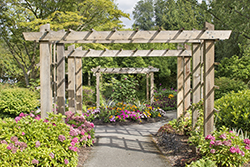Arbor Day is April 28
Celebrating Trees in Kentucky Cities
This year marks the 150th anniversary of Arbor Day, a day dedicated to celebrating the importance of trees and community forestry.
"Community forestry applies to cities of all sizes," said Bridget Abernathy, urban forestry coordinator for the Kentucky Division of Forestry. "An urban forest makes our neighborhoods safer; it makes people shop longer; it makes traffic slow down. There are many reasons to have a more abundant urban forest in our communities."
She said that a community's green space is an important indicator of many things, including a city's overall quality of life. Green infrastructure affects a lot more than the aesthetics of a place.
Abernathy said green spaces make our cities walkable, livable, breathable, and more appealing to potential businesses and residents. To her point, research shows that green spaces increase economic development opportunities and property values.
"We have science and sociology behind the benefits of community forestry," Abernathy said.
According to the Center for Urban Horticulture at the University of Washington, urban forests are a significant and increasingly valuable asset. Eighty-six percent of real estate appraisers surveyed agreed that landscaping added to the dollar value of commercial real estate, and 92 percent agreed it added to sales appeal. Another study that looked at 30 variables of commercial occupancy rates suggested that landscape amenities were more important than direct access to arterial routes.

In terms of residential property values, healthy trees also influence house prices. Trees increase home values from four to six percent on average. For instance, a 25-foot tree can reduce annual heating and cooling costs by eight to 12 percent, and a mature tree canopy reduces air temperature by up to 10 degrees, lowering the internal temperatures of nearby structures.
As you may recall from middle school biology class, trees release oxygen. The average person consumes about 386 pounds of oxygen per year. A healthy 32-foot tree can produce up to 260 pounds of oxygen annually, so two trees can supply the oxygen needed for a person for a year! A mature tree absorbs small particles and gases in air pollution. And street tree canopies absorb rain, reducing the amount of water that will fall on the pavement and wind up in the stormwater drainage system.
The Arbor Day Foundation designates 37 Kentucky cities as a Tree City USA®. You can get more information and requirements for the program here, which provides communities a four-step framework to maintain and grow their tree cover.
Several cities in Kentucky employ certified arborists. Many more work with arborists on a contractual basis. Other cities currently have tree boards. That is a good place to start if your city wants to implement a strategic, well-thought-out approach to urban forestry. KLC Municipal Law can help with the establishment of such a board.
The Arbor Day Foundation has helpful information on forming a tree board as week as a Handbook for Tree Board Members. For sample ordinances regarding tree boards, contact the KLC Municipal Law Department, one of the Tree City USA® cities, or the Kentucky Division of Forestry.
"Tree boards represent the trees and the people,” Abernathy stated.
If you already have or choose to start a tree board, it is important to make sure a portion of the board is composed of people with expertise in trees and plants, not just an interest in them.
While good planning is an asset, poor planning is costly and can make matters much worse in terms of tree placement, invasive species, root issues, and even public safety. Protecting trees does not have to be prohibitive, but cities need to consider the implications of new development, water lines, and heritage trees as they look at growth and redevelopment projects. She suggests cities start small with some type of awareness or educational event to gauge local interest in trees and involve the public. Have a community tree planting event or simply celebrate Arbor Day.
There's ample time to start planning for Arbor Day, which is April 28. There are plenty of resources here to get started.
"Nothing about community forestry should be overwhelming for a city or its staff," Abernathy said. "Just start out small and build the public interest. There are lots of great resources, and we are happy to help cities get started."


